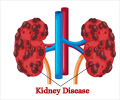Interrupting the blood flow for more than 20 to 25 minutes during kidney cancer surgery leads to a greater risk for patients developing chronic kidney disease, says study

Using a technique called warm ischemia, surgeons kept the patient's kidneys at body temperature during the partial nephrectomy.
Ischemia involves cutting off the blood supply to the kidney with clamps in order to control bleeding and to keep blood from obscuring the surgeon's view of the kidney.
It also allows for precise closure of the urine collecting system and the surgical opening. The median ischemia time was 21 minutes in the study and the median age of patients was 62 years.
Ischemia can cause tissue damage from a lack of oxygen and nutrients. Researchers found that each additional minute of warm ischemia is associated with a 5 to 6 percent increase in the odds of developing acute renal failure or reduced kidney functioning and is associated with a 6 percent increased risk of new onset Stage IV chronic kidney disease during long-term follow-up.
"This is the largest evaluation of warm ischemia time in patients with a single kidney who are undergoing a partial nephrectomy, combining the experiences of the Mayo Clinic and Cleveland Clinic, both leaders in the field of kidney cancer," said R. Houston Thompson, Mayo Clinic urologist and the study's primary investigator.
Advertisement
"Historically, 30 minutes was considered the maximum safe duration of warm ischemia during partial nephrectomy, and other retrospective clinical studies have suggested that warm ischemia for 40 to 55 minutes is safe. However, these studies included patients with two kidneys, which could mask the true effects of ischemia on renal function.
Advertisement
The researchers stressed that the study's results do not have implications for patients treated with cold ischemia.
The study was published today in the journal, European Urology.
Source-ANI















